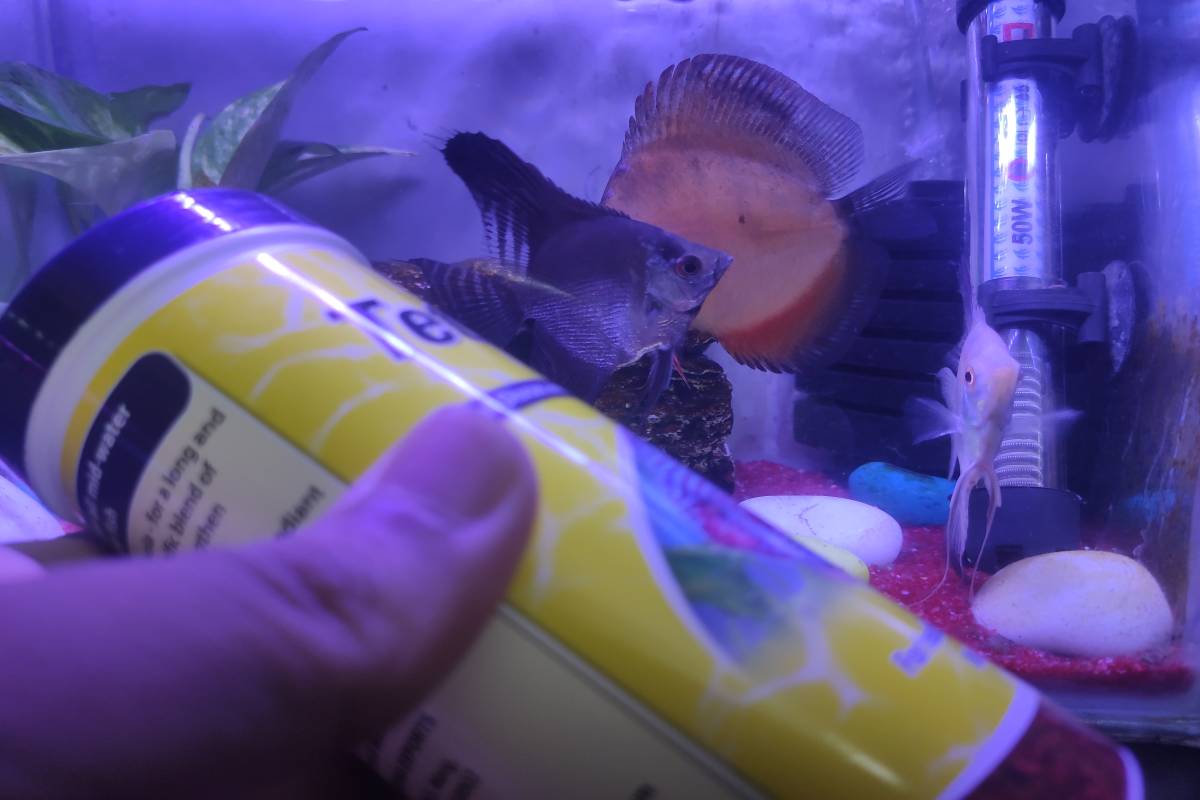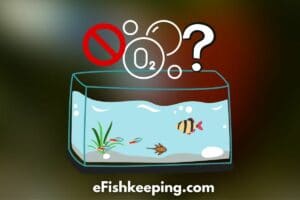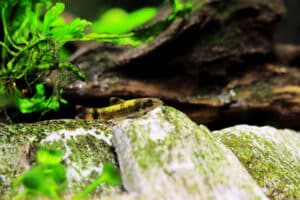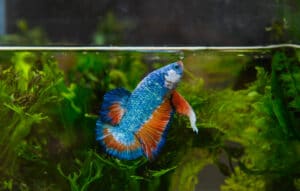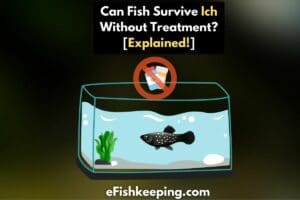In this guide, you’ll learn about the frequency of feeding angelfish, how long they can live without food and more. So without further ado, let’s jump right in!
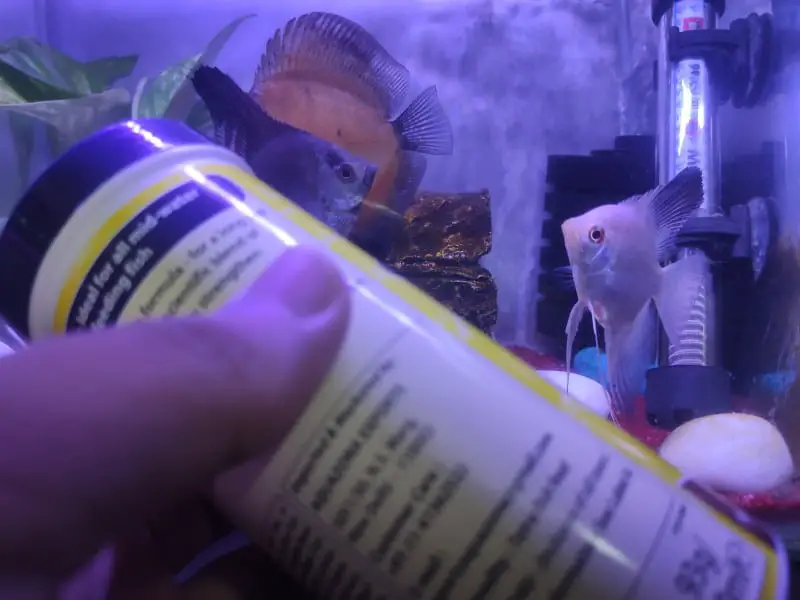
Here’s How Often You Should Feed An Angelfish:
As a general rule, you should feed angelfish only once a day if you want a regular growth rate and want to avoid frequent water changes. However, if you want to grow your angelfish faster, you can feed them twice or thrice a day, provided you maintain the tank adequately.
More feeding invites a couple of problems, and out of them, the most striking problem is more frequent water change.
You know that in fishkeeping, it is required to regularly change the water to maintain proper water parameters. But let’s face it, it’s only sometimes possible to do more frequent water changes if you have a hectic life.
And feeding your angelfish more often in a day will only help to make the tank dirtier than it would usually get!
Typically, for the normal growth rate of your angelfish, feeding once a day is enough.
However, if you want to grow your angelfish faster, you can surely feed them more often in a day. Usually, 2-3 times a day is recommended.
But if you give them a SMALL quantity of high proteinaceous food, you can spread their meal into 5-6 feedings.
How Often To Feed Baby Angelfish?
For newborn baby angelfish, you should feed them 3-4 times a day. And you can keep feeding them roughly four times a day until they become three or four weeks old.
Baby angelfish will have more metabolism and nutritional demands than a typical adult angelfish fish. Why? Because they are in their growth phase, where all the cells and tissues of the baby angelfish grow day by day.
But as your angelfish becomes an adult, you can slow down the feeding frequency if you want average growth. (Typically, at the six-month mark, you can consider your angelfish as an adult).
Once the angelfish reach adulthood, their growth rate will gradually fall. In other words, they will still grow, but the pace of growth will be slower. So by that time, you can choose to feed them 1-3 times a day.
If you are relying only on one type of food for your angelfish, that’s fine too. But ensure you select the best quality flakes for your angelfish.

We highly recommend checking out and sticking with food like this one (available on Amazon). And if you are only relying on flakes, feeding once a day is enough for normal growth.
Don’t worry about starving; if you feed them adequately, they should be doing good in the tank.
Now let’s dig into some of the signs that will help you spot whether your angelfish are hungry or not.
How To Know Your Angelfish Is Hungry?
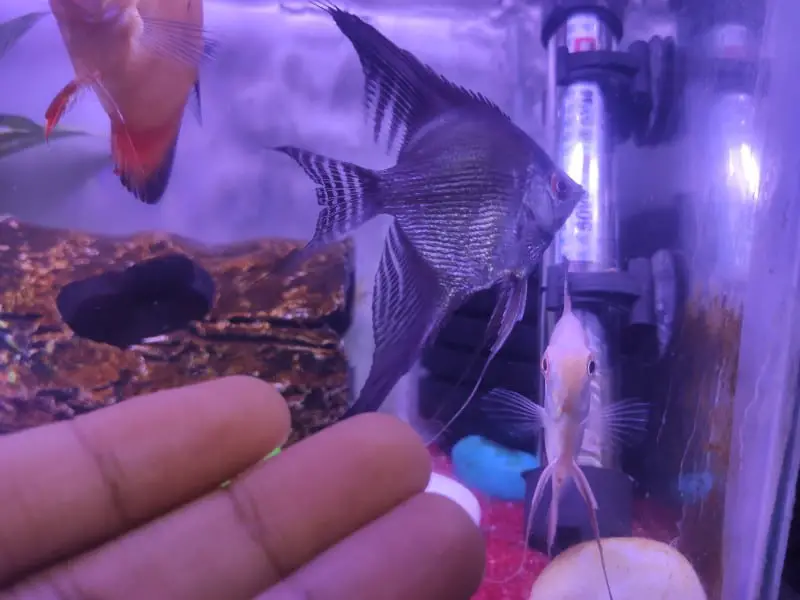
Here are some signs to identify your angelfish is hungry:
- Notice for aggression. Once your angelfish becomes hungry, you’ll notice the aggression among your angelfish – pecking at each other or constantly searching for something.
- Look if they often hang out at the top of the tank. If you feed your angelfish at a particular spot daily, they will likely come to the same place (just the nature of animal habit formation). And if you find them more often hanging out at the tank top, it can be because they are feeling hungry.
Please note there can also be other reasons why an angelfish would come to the top of the tank, like low oxygen in the tank. So if your angelfish is completely healthy, the tank parameters are good, and still, you find them at their favorite feeding spot more frequently – it’s an indication of them being hungry.
Should you increase the frequency of feeding if you find them hungry? Well, if you feel you can. So, for instance, if you were feeding them only once a day, after finding them staying hungry the rest of the time, you can increase the frequency and make the feeding routine up to 2 times a day. And see how it goes.
But, whatever routine you choose, please make sure to follow these essential rules:
- Never overfeed your angelfish.
- Avoid feeding so often that uneaten food gets collected in the tank and disturbs the water parameters.
Now let’s say you are about to go on a short trip. Then, it’s quite natural to wonder how long your angelfish will be able to live without feeding.
Here’s How Long An Angelfish Can Live Without Food:
Generally, angelfish (especially the adults) can live up to 3 days to a week or two without food. But that doesn’t mean you should leave them for that time without food. It’s best to have someone in your home (like a pet sitter) who can feed them regularly.

Also, there are automatic fish feeders like this one (available on Amazon).
The general working principle of the automatic fish feeders is simple:
You need to program the feeder as per your needs and fill it with your angelfish fish favorite foods. Then, the device will keep dropping the food in the tank whenever the feeding time comes.
How Much Should You Feed Your Angelfish?
Feeding your angelfish a pinch of food at a time should be enough. The general rule is to feed your angelfish so they can complete it within 30 seconds.
Imagine this:
How big would your angelfish stomach be?
Now whatever you have imagined, their stomach would be no way more than their small body size. Right? So feeding them a lot of flakes won’t make sense.
Only a pinch of flakes at a time is good to go!
Here’s a general fish anatomy. Look at the stomach and analyze how big it is to have the better feel of it.

How To Know Your Angelfish Has Eaten Enough?
This requires a bit of trial and error if you are looking for perfection. But the general rule is to feed your angelfish enough food that they can consume in 30 seconds, or at the most up to 60 seconds.
If you drop the flakes and you find them floating around in the tank, none of your Angelfish are paying any attention to it. That’s the sign you have overfed them.
So the next time you feed them, try to reduce the number of extra flakes you dropped in the tank.
Repeat this until you see no more extra flakes floating around in the tank. That way, you can reach the perfect amount of flakes you need to give your angelfish. You can also use the lid of the food container as your rough measuring tool.

At What Time Should You Feed Your Angelfish?
The best time to feed your angelfish is in the morning or the evening. However, since angelfish are not nocturnal, avoid feeding them during the night while they are sleepy.
In the wild, fish species always remain in search of food, and they won’t hesitate to gulp if they find their favorite pick. But it’s not good to pay attention to such behavior in the tank and feed them whenever they seem willing because that can cause overfeeding. So instead, make a routine!
If you feed your angelfish only once a day, the best would be to feed them in the morning (like before you go to work). And if that’s not possible, you can also feed them during the evening after you return home.
It is essential to stick with a routine and follow it regularly.
Angelfish Feeding Habit

Angelfish are mostly top and mid-level feeders in the tank. So most of the time, you’ll find them looking for food and hovering around the top part of the fish tank. Angelfish are typically omnivores and can eat frozen or live food, flakes, and pellets.
However, they sometimes search for food at the bottom for crustaceans or worms in the wild.
If you have been feeding your angelfish regularly, you will notice them coming near whenever they see you (especially with their favorite flakes container), begging for food. Although they might stop themselves once their stomach feels full, usually, they will keep feeding whenever they get the chance.
In the wild, there’s no straightforward routine of food availability for any fish. So they eat whenever they get the chance. And this habit also gets expressed in the tank habitat.
Here’s the thing:
The cute angels of your aquarium don’t need that much food as they beg for it! At last, they tend to just eat and eat without knowing when to stop. Our duty as fishkeepers is not to overfeed them and ensure their better health.
What Happens If Angelfish Are Fed Too Much?
Overfeeding an angelfish can lead to multiple problems, negatively impacting their health and the tank ecosystem.
- As you feed your angelfish too much, they will start suffering from problems like improper digestion and constipation.
- The next biggest issue – your tank water parameters will get disturbed because more feeding = more waste build up in the tank (the fish producing more waste + the uneaten food that remains in the tank and increases the ammonia and nitrate levels)
- The uneaten extra food pellets will get collected and decay, which consumes the oxygen from the tank water. And the result is less dissolved oxygen for the angelfish to thrive.
- Moreover, there will be more algae growth in the tank (because the excess waste that builds up in the water now acts as a nutrient source for the algae to increase in number).
Final Words
In short, as you start overfeeding, the chances of health-related issues in your Angelfish increase. Furthermore, you have to do more frequent water changes than usual to cope with the additional waste build-up in the tank.
Therefore, it’s wise to feed your angelfish only enough to what they need rather than overfeeding. Once a day is enough. But if you want faster growth, you can choose 2-3 times daily.
With feeding the fish, usually, less is good because we often overestimate and overfeed them, which does more harm than good.
So that’s it! We hope the tips and information we shared in this post help you to decide the perfect feeding frequency and feeding portions for your angelfish. Best of luck and happy angelfish keeping!
Read More Posts On Angelfish:
Hi! I’m Praveen Ghoshal, the founder of eFishkeeping.com. Inspired by my Dad, I got interested in fishkeeping when I was a kid. Since then, I have been involved with this hobby. Currently, I have 3 fish tanks at our home, and I enjoy this hobby with my full family. Read more about me here.

